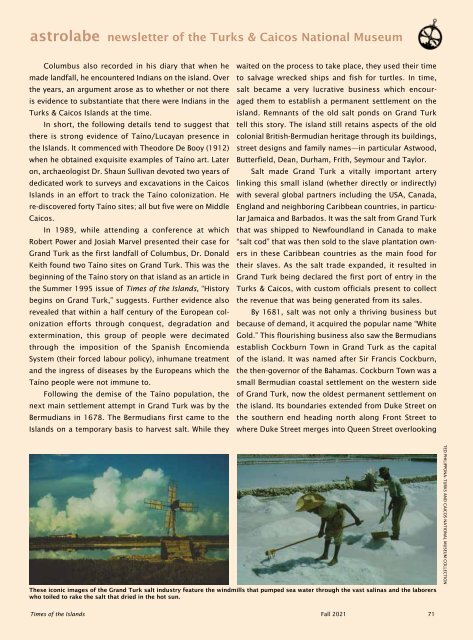Times of the Islands Fall 2021
Presents the "soul of the Turks & Caicos Islands" with in-depth features about local people, culture, history, environment, real estate, businesses, resorts, restaurants and activities.
Presents the "soul of the Turks & Caicos Islands" with in-depth features about local people, culture, history, environment, real estate, businesses, resorts, restaurants and activities.
You also want an ePaper? Increase the reach of your titles
YUMPU automatically turns print PDFs into web optimized ePapers that Google loves.
astrolabe newsletter <strong>of</strong> <strong>the</strong> Turks & Caicos National Museum<br />
Columbus also recorded in his diary that when he<br />
made landfall, he encountered Indians on <strong>the</strong> island. Over<br />
<strong>the</strong> years, an argument arose as to whe<strong>the</strong>r or not <strong>the</strong>re<br />
is evidence to substantiate that <strong>the</strong>re were Indians in <strong>the</strong><br />
Turks & Caicos <strong>Islands</strong> at <strong>the</strong> time.<br />
In short, <strong>the</strong> following details tend to suggest that<br />
<strong>the</strong>re is strong evidence <strong>of</strong> Taíno/Lucayan presence in<br />
<strong>the</strong> <strong>Islands</strong>. It commenced with Theodore De Booy (1912)<br />
when he obtained exquisite examples <strong>of</strong> Taíno art. Later<br />
on, archaeologist Dr. Shaun Sullivan devoted two years <strong>of</strong><br />
dedicated work to surveys and excavations in <strong>the</strong> Caicos<br />
<strong>Islands</strong> in an effort to track <strong>the</strong> Taíno colonization. He<br />
re-discovered forty Taíno sites; all but five were on Middle<br />
Caicos.<br />
In 1989, while attending a conference at which<br />
Robert Power and Josiah Marvel presented <strong>the</strong>ir case for<br />
Grand Turk as <strong>the</strong> first landfall <strong>of</strong> Columbus, Dr. Donald<br />
Keith found two Taíno sites on Grand Turk. This was <strong>the</strong><br />
beginning <strong>of</strong> <strong>the</strong> Taíno story on that island as an article in<br />
<strong>the</strong> Summer 1995 issue <strong>of</strong> <strong>Times</strong> <strong>of</strong> <strong>the</strong> <strong>Islands</strong>, “History<br />
begins on Grand Turk,” suggests. Fur<strong>the</strong>r evidence also<br />
revealed that within a half century <strong>of</strong> <strong>the</strong> European colonization<br />
efforts through conquest, degradation and<br />
extermination, this group <strong>of</strong> people were decimated<br />
through <strong>the</strong> imposition <strong>of</strong> <strong>the</strong> Spanish Encomienda<br />
System (<strong>the</strong>ir forced labour policy), inhumane treatment<br />
and <strong>the</strong> ingress <strong>of</strong> diseases by <strong>the</strong> Europeans which <strong>the</strong><br />
Taíno people were not immune to.<br />
Following <strong>the</strong> demise <strong>of</strong> <strong>the</strong> Taíno population, <strong>the</strong><br />
next main settlement attempt in Grand Turk was by <strong>the</strong><br />
Bermudians in 1678. The Bermudians first came to <strong>the</strong><br />
<strong>Islands</strong> on a temporary basis to harvest salt. While <strong>the</strong>y<br />
waited on <strong>the</strong> process to take place, <strong>the</strong>y used <strong>the</strong>ir time<br />
to salvage wrecked ships and fish for turtles. In time,<br />
salt became a very lucrative business which encouraged<br />
<strong>the</strong>m to establish a permanent settlement on <strong>the</strong><br />
island. Remnants <strong>of</strong> <strong>the</strong> old salt ponds on Grand Turk<br />
tell this story. The island still retains aspects <strong>of</strong> <strong>the</strong> old<br />
colonial British-Bermudian heritage through its buildings,<br />
street designs and family names—in particular Astwood,<br />
Butterfield, Dean, Durham, Frith, Seymour and Taylor.<br />
Salt made Grand Turk a vitally important artery<br />
linking this small island (whe<strong>the</strong>r directly or indirectly)<br />
with several global partners including <strong>the</strong> USA, Canada,<br />
England and neighboring Caribbean countries, in particular<br />
Jamaica and Barbados. It was <strong>the</strong> salt from Grand Turk<br />
that was shipped to Newfoundland in Canada to make<br />
“salt cod” that was <strong>the</strong>n sold to <strong>the</strong> slave plantation owners<br />
in <strong>the</strong>se Caribbean countries as <strong>the</strong> main food for<br />
<strong>the</strong>ir slaves. As <strong>the</strong> salt trade expanded, it resulted in<br />
Grand Turk being declared <strong>the</strong> first port <strong>of</strong> entry in <strong>the</strong><br />
Turks & Caicos, with custom <strong>of</strong>ficials present to collect<br />
<strong>the</strong> revenue that was being generated from its sales.<br />
By 1681, salt was not only a thriving business but<br />
because <strong>of</strong> demand, it acquired <strong>the</strong> popular name “White<br />
Gold.” This flourishing business also saw <strong>the</strong> Bermudians<br />
establish Cockburn Town in Grand Turk as <strong>the</strong> capital<br />
<strong>of</strong> <strong>the</strong> island. It was named after Sir Francis Cockburn,<br />
<strong>the</strong> <strong>the</strong>n-governor <strong>of</strong> <strong>the</strong> Bahamas. Cockburn Town was a<br />
small Bermudian coastal settlement on <strong>the</strong> western side<br />
<strong>of</strong> Grand Turk, now <strong>the</strong> oldest permanent settlement on<br />
<strong>the</strong> island. Its boundaries extended from Duke Street on<br />
<strong>the</strong> sou<strong>the</strong>rn end heading north along Front Street to<br />
where Duke Street merges into Queen Street overlooking<br />
These iconic images <strong>of</strong> <strong>the</strong> Grand Turk salt industry feature <strong>the</strong> windmills that pumped sea water through <strong>the</strong> vast salinas and <strong>the</strong> laborers<br />
who toiled to rake <strong>the</strong> salt that dried in <strong>the</strong> hot sun.<br />
TED PHILIPPONA–TURKS AND CAICOS NATIONAL MUSEUM COLLECTION<br />
<strong>Times</strong> <strong>of</strong> <strong>the</strong> <strong>Islands</strong> <strong>Fall</strong> <strong>2021</strong> 71

















